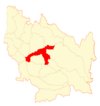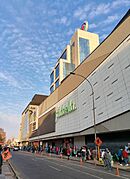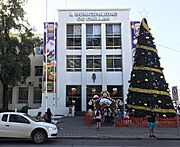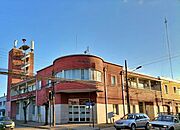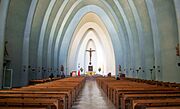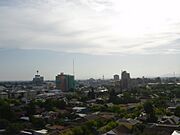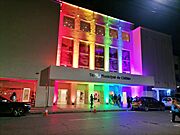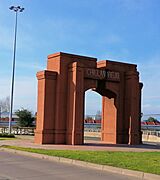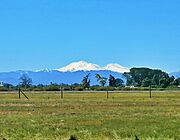Chillán facts for kids
Quick facts for kids
Chillán
|
|||||
|---|---|---|---|---|---|
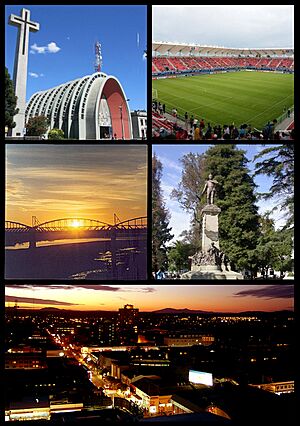
Clockwise, from top: Chillán Cathedral, Nelson Oyarzún Arenas Stadium, puente ferroviario de Ñuble, Statue of Bernardo O'Higgins, panoramic view of the city at sunset.
|
|||||
|
|||||
| Country | Chile | ||||
| Region | Ñuble | ||||
| Province | Diguillín | ||||
| Founded | 1580 | ||||
| Founded by | Martín Ruiz de Gamboa | ||||
| Government | |||||
| • Type | Municipality | ||||
| Area | |||||
| • Total | 511.2 km2 (197.4 sq mi) | ||||
| Elevation | 124 m (407 ft) | ||||
| Population
(2012 Census)
|
|||||
| • Total | 174,777 | ||||
| • Density | 341.90/km2 (885.51/sq mi) | ||||
| • Urban | 148,015 | ||||
| • Rural | 13,938 | ||||
| Demonym(s) | Chillanejo or Chillanense | ||||
| Sex | |||||
| • Men | 77,007 | ||||
| • Women | 84,946 | ||||
| Time zone | UTC−4 (CLT) | ||||
| • Summer (DST) | UTC−3 (CLST) | ||||
| Postal code |
3780000
|
||||
| Area code(s) | country + city = 56 + 42 | ||||
| Climate | Csb | ||||
| Website | Official website: http://www.municipalidadchillan.cl/ | ||||
Chillán (Spanish pronunciation: [tʃiˈʝan]) is an important city in Chile. It is the capital of the Ñuble Region and Diguillín Province. The city is located about 400 kilometers (250 miles) south of Santiago, Chile's capital. Chillán became the capital of the new Ñuble Region in 2015.
The city has a train station and a large bus terminal. You can also find a modern shopping mall here. Chillán is famous for its big open-air market, the Chillán Market. Here, you can buy fresh fruits, vegetables, crafts, and clothes. Nearby mountains like Laguna del Laja National Park and the Nevados de Chillán (which means 'snowy peaks of Chillán') are great for skiing, hiking, and visiting hot springs.
Spanish explorers founded Chillán in 1580. The city faced many attacks from local groups like the Mapuche and Pehuenche people. These groups did not want Spanish rule. Over time, Chillán became a key place for trade and meetings. People from different backgrounds, including Mapuche, Pehuenche, and Spanish descendants, met here. Goods from Patagonia and the Argentine Pampas were often brought to Chillán.
In the early 1800s, the area around Chillán was affected by the Chilean War of Independence. Later, in 1939, a huge earthquake destroyed much of the city. This led to a large rebuilding effort by the government.
Contents
History of Chillán
The area where Chillán was built was once home to the Chiquillanes people. The name "Chillán" might come from an indigenous word "chilla," which means South American gray fox. Another idea is that it means "where the Sun is sitting" in the local language.
Martín Ruiz de Gamboa founded the city in 1580. He first named it San Bartolomé de Chillán, but the name Chillán became more popular.
In 1655, during a Mapuche uprising, warriors surrounded the city. The Spanish tried to defend it. Eventually, they had to leave the city and move north to escape the fighting.
Chillán has always been important for farming in Chile. It is also in an area with many earthquakes. The 1939 Chillán earthquake was very strong, causing over 30,000 deaths. This disaster led to international help for the city.
Bernardo O'Higgins, a very important person in Chile's history, was born in Chillán in 1778. He led Chile to become independent from Spain. He was elected as the leader and declared independence after the Battle of Chacabuco in 1817. His victory at the Battle of Maipú helped secure Chile's freedom.
Climate in Chillán
Chillán has a Mediterranean climate. This means it has cool, mild winters and warm, dry summers. Most of the rain falls during winter, from May to July. Summers are usually dry, with very little rain from December to February. Temperatures can sometimes go above 30°C (86°F) from October to April.
The average yearly rainfall is about 1058 mm (41.7 inches). However, the amount of rain can change a lot each year.
| Climate data for Chillan (General Bernardo O'Higgins Airport) 1991–2020, extremes 1950–present | |||||||||||||
|---|---|---|---|---|---|---|---|---|---|---|---|---|---|
| Month | Jan | Feb | Mar | Apr | May | Jun | Jul | Aug | Sep | Oct | Nov | Dec | Year |
| Record high °C (°F) | 41.5 (106.7) |
41.6 (106.9) |
37.8 (100.0) |
31.8 (89.2) |
27.0 (80.6) |
23.2 (73.8) |
20.4 (68.7) |
25.2 (77.4) |
28.5 (83.3) |
31.9 (89.4) |
36.3 (97.3) |
36.6 (97.9) |
41.6 (106.9) |
| Mean daily maximum °C (°F) | 29.6 (85.3) |
29.2 (84.6) |
26.3 (79.3) |
20.6 (69.1) |
15.3 (59.5) |
12.3 (54.1) |
12.1 (53.8) |
14.1 (57.4) |
17.0 (62.6) |
19.7 (67.5) |
23.4 (74.1) |
26.8 (80.2) |
20.5 (68.9) |
| Daily mean °C (°F) | 20.5 (68.9) |
19.9 (67.8) |
17.6 (63.7) |
13.6 (56.5) |
10.5 (50.9) |
8.5 (47.3) |
7.8 (46.0) |
9.2 (48.6) |
11.1 (52.0) |
13.2 (55.8) |
15.9 (60.6) |
18.5 (65.3) |
13.9 (57.0) |
| Mean daily minimum °C (°F) | 11.4 (52.5) |
10.6 (51.1) |
9.0 (48.2) |
6.6 (43.9) |
5.6 (42.1) |
4.7 (40.5) |
3.5 (38.3) |
4.2 (39.6) |
5.1 (41.2) |
6.7 (44.1) |
8.3 (46.9) |
10.2 (50.4) |
7.2 (45.0) |
| Record low °C (°F) | 1.8 (35.2) |
2.0 (35.6) |
−1.2 (29.8) |
−2.8 (27.0) |
−5.9 (21.4) |
−6.3 (20.7) |
−7.0 (19.4) |
−4.6 (23.7) |
−3.2 (26.2) |
−2.0 (28.4) |
0.5 (32.9) |
0.0 (32.0) |
−7.0 (19.4) |
| Average precipitation mm (inches) | 8.7 (0.34) |
24.4 (0.96) |
17.8 (0.70) |
65.9 (2.59) |
160.2 (6.31) |
211.4 (8.32) |
149.3 (5.88) |
123.9 (4.88) |
70.1 (2.76) |
58.0 (2.28) |
27.7 (1.09) |
18.8 (0.74) |
936.2 (36.86) |
| Average precipitation days (≥ 1.0 mm) | 1.1 | 1.5 | 2.0 | 4.9 | 8.9 | 12.3 | 10.6 | 9.8 | 6.5 | 5.7 | 2.7 | 2.2 | 68.2 |
| Average relative humidity (%) | 50 | 53 | 58 | 68 | 80 | 85 | 83 | 78 | 72 | 67 | 60 | 54 | 67 |
| Mean monthly sunshine hours | 359.6 | 296.6 | 260.4 | 177.0 | 120.9 | 87.0 | 105.4 | 142.6 | 183.0 | 229.4 | 282.0 | 334.8 | 2,578.7 |
| Mean daily sunshine hours | 11.6 | 10.5 | 8.4 | 5.9 | 3.9 | 2.9 | 3.4 | 4.6 | 6.1 | 7.4 | 9.4 | 10.8 | 7.1 |
| Source 1: Dirección Meteorológica de Chile (humidity 1970–2000) | |||||||||||||
| Source 2: NOAA (precipitation days 1991–2020), Universidad de Chile (sunshine hours only) | |||||||||||||
Chillán's air quality is sometimes affected by pollution. This is mainly because many homes use wood-burning stoves for heating.
People of Chillán
In 2002, Chillán had about 161,953 people. Most of them (over 90%) lived in the city, while a smaller number lived in rural areas. The population grew by about 8% between 1992 and 2002.
People from Chillán are called Chillanejo or Chillanense.
Famous People from Chillán
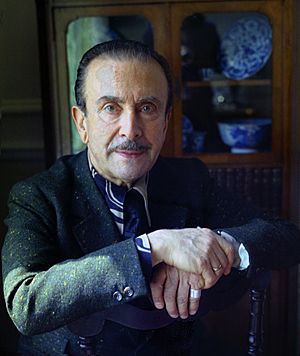
Many famous people were born in Chillán:
- Isabel Riquelme: She was the mother of Bernardo O'Higgins, Chile's independence leader.
- María Cornelia Olivares: A national heroine from the Chilean War of Independence.
- Claudio Arrau: A world-famous pianist. He was known for his amazing musical talent.
- Ramón Vinay: A famous opera singer, known for his powerful voice. He sang in many major opera houses.
- Marta Brunet: A well-known writer.
- Marta Colvin: A talented sculptor.
- Pacheco Altamirano: A notable painter.
- Juan de Dios Aldea: A national hero.
- Gonzalo "ZeRo" Barrios: A professional video game player, famous for his skills in Super Smash Bros.. He once won 56 tournaments in a row!
How Chillán is Governed
Chillán is a commune, which is a local government area in Chile. It is managed by a municipal council. The head of the council is called an alcalde (mayor). The alcalde is chosen by the people in an election every four years. The current alcalde is Camilo Benavente.
Transportation
Chillán is well-connected to Santiago, Chile's capital. You can travel between the cities using a modern highway or a rebuilt railway system called TerraSur. The train ride takes less than five hours. The TerraSur train ends at Chillán station. Another train, the Alameda-Temuco train, also connects Chillán with Rancagua and Santiago.
Gallery
See also
 In Spanish: Chillán para niños
In Spanish: Chillán para niños



